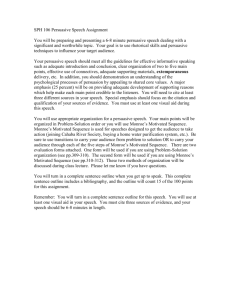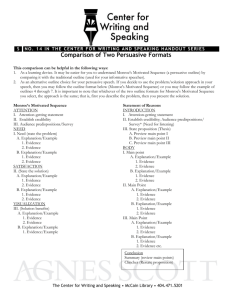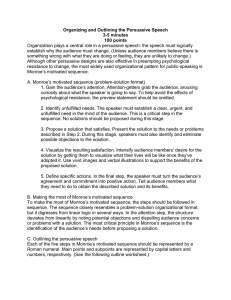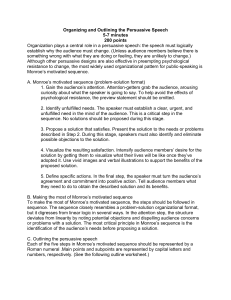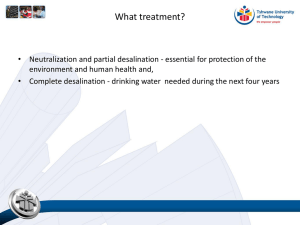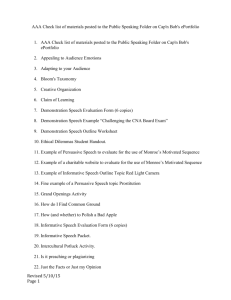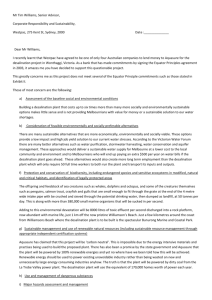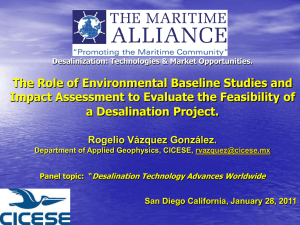Organizing and Outlining the Persuasive Speech
advertisement
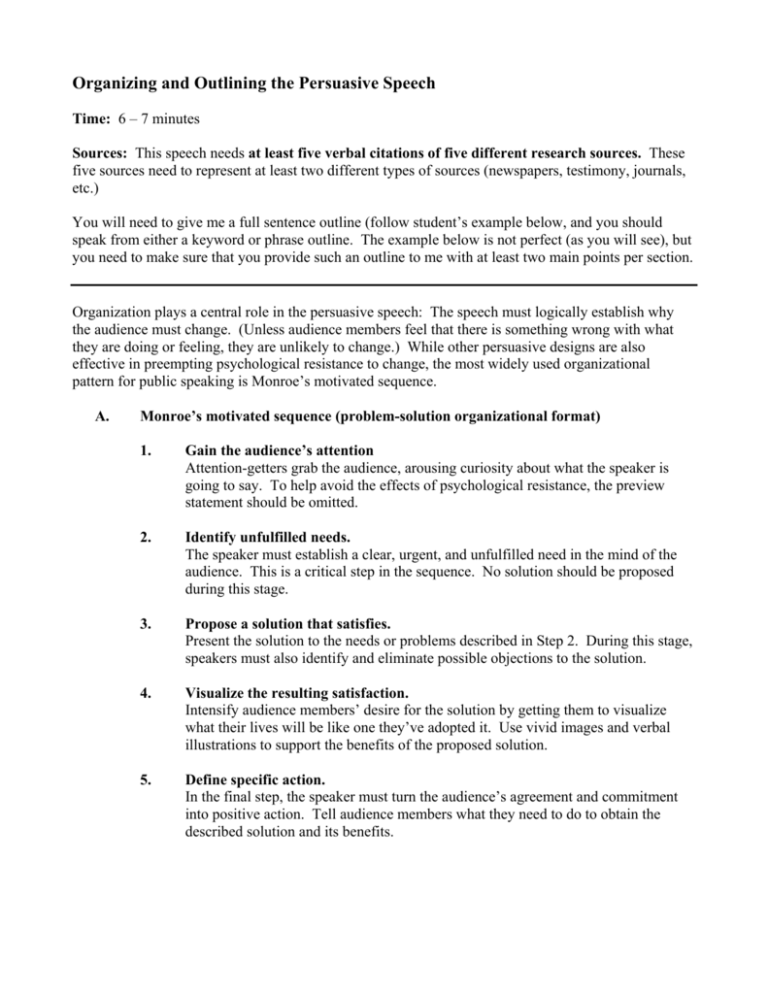
Organizing and Outlining the Persuasive Speech Time: 6 – 7 minutes Sources: This speech needs at least five verbal citations of five different research sources. These five sources need to represent at least two different types of sources (newspapers, testimony, journals, etc.) You will need to give me a full sentence outline (follow student’s example below, and you should speak from either a keyword or phrase outline. The example below is not perfect (as you will see), but you need to make sure that you provide such an outline to me with at least two main points per section. Organization plays a central role in the persuasive speech: The speech must logically establish why the audience must change. (Unless audience members feel that there is something wrong with what they are doing or feeling, they are unlikely to change.) While other persuasive designs are also effective in preempting psychological resistance to change, the most widely used organizational pattern for public speaking is Monroe’s motivated sequence. A. Monroe’s motivated sequence (problem-solution organizational format) 1. Gain the audience’s attention Attention-getters grab the audience, arousing curiosity about what the speaker is going to say. To help avoid the effects of psychological resistance, the preview statement should be omitted. 2. Identify unfulfilled needs. The speaker must establish a clear, urgent, and unfulfilled need in the mind of the audience. This is a critical step in the sequence. No solution should be proposed during this stage. 3. Propose a solution that satisfies. Present the solution to the needs or problems described in Step 2. During this stage, speakers must also identify and eliminate possible objections to the solution. 4. Visualize the resulting satisfaction. Intensify audience members’ desire for the solution by getting them to visualize what their lives will be like one they’ve adopted it. Use vivid images and verbal illustrations to support the benefits of the proposed solution. 5. Define specific action. In the final step, the speaker must turn the audience’s agreement and commitment into positive action. Tell audience members what they need to do to obtain the described solution and its benefits. B. Making the most of Monroe’s motivated sequence To make the most of Monroes’ motivated sequence, the steps should be followed in sequence. The sequence closely resembles a problem-solution organizational format, but it digresses from linear logic in several ways. In the attention step, the structure tends to deviate from linearity by noting potential objections and dispelling audience concerns or problems with a solution. The most critical principle in Monroe’s motivated sequence is the identification of the audience’s needs before proposing a solution. C. Outlining the persuasive speech Each of the five steps in Monroe’s motivated sequence should be represented by a Roman numeral. Main points and subpoints are represented by capital letters and numbers, respectively. Sample Outline for Monroe’s Motivated Sequence Persuasive Speech Title: Desalination in the Middle East Speaker: Specific Purpose: To persuade my audience that desalination in the Middle East as a water supplement is much needed. I. A. Introduction Attention-getter: Imagine seeing a small child in the street who is starving. If you don’t help this child obtain nutrition, she will turn to crime to get money for food. You must help her. B. Establishment of ethos: This child is like the Middle East and its need for water. C. Thematic statement: This Middle East needs more water or it will wage war for control of water. Desalination is the key. (Transition: I will tell you how desalination can allow you to help Middle Easterners just as you would help a starving child.) II. A. Need Middle Easterners are currently getting their water from underground aquifers and from area rivers and streams (show visual aid). B. The existing water supply is dwindling fast. In a 1994 article in Audubon, Bruce Stutz says that the region’s aquifers and rivers are drying out. C. According to P. J. Vesilind of National Geographic, the area will soon break out in “water wars” because water is now more precious than oil. In the same article in Audubon, Bruce Stutz (1994) says that there can be no peace in the area until the water crisis is solved. D. As the world’s “police force” and the nation that supplies most of the human power to the United Nations’ operations, the United States may soon be involved in these wars as well. Take, for example, the Persian Gulf War. (Internal Summary: All of this shows that water is very precious and that if we don’t act soon, war will probably be the result.) (Transition: Now that we see there is such a problem, we need to find a solution.) III. A. Satisfaction Middle Easterners need more usable water, as well as the technology to clean up existing polluted waters. B. Irwin Ploss and Jonathan Rubinstein of The New Republic said in 1992 that desalination was the only real source of new fresh water in that region. C. Desalination is like reverse osmosis – it takes out salts and other pollutants. D. The United States has the technology to do this now, and it is improving all the time. Desalination is currently being used in Florida and parts of California to increase water supply. E. The Middle East has the capability and the desire for change – the technology is already being implemented. F. It is good for the environment. (Internal summary: All of this shows that there is a plausible solution to the water crisis in the Middle East.) (Transition: Now that we know there is a solution to the problem, why should we as Americans get involved and what can we as individuals do about it?) IV. A. Visualization The United States doesn’t want to be involved in any more wars in that region. B. We can prevent wars from happening. C. It will cost money to help the Middle East with desalination, but it will be less expensive in the long run because war is so expensive. (Internal summary: We can now see how desalination could be the key to peace in the Middle East.) (Transition to conclusion: Now what can we as Americans do to help implement this process of maintaining peace?) V. A. Action Summarize and review taking action (overall theme including each step of Monroe’s motivated sequence): There is a water shortage. Middle Easterners are willing to go to war over this shortage. Desalination can prevent water wars by eliminating the water shortage. Write your congressperson to tell him or her to support peace in the Middle East. B. Tie to introduction: By doing this you are helping the Middle East survive without violence or crime. C. Creative concluding thought (end with impact): Desalination is the key, and now you know how you can help the poor starving child to survive. References: Budiansky, S. (1995, April 9). Another obstacle to peace. U.S. News & World Report, 60-62. Desalination. (Publication No. 33.10:91-5). Washington. D.C.: U.S. Government Printing Office. Ploss, I., & Rubinstein, J. (1992, September 7-14). Water for peace. The New Republic, 20-22. Science Reference Section, Science and Technology Division, LOC. (1991). Stutz, B. (1994, September). Water and peace. Audubon, 66-76. Vesilind, P. J. (1993, May). The Middle East’s water: A critical resource. National Geographic, 3871.
